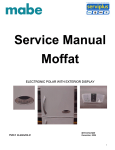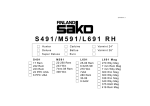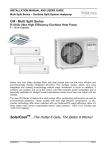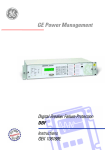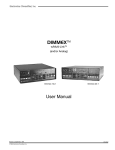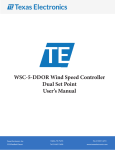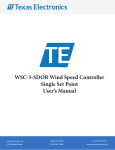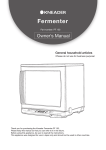Download mabe ESTILO Service manual
Transcript
mabe SERVICE MANUAL FOR SEDNA “ESTILO” REFRIGERATORS from Mabe and G.E. PUB # 06-MAN/RE-02 1 2 mabe TABLE OF CONTENTS OVERVIEW FEATURES Alarm, vacation mode, levels, turbo mode TECHNICAL DATA Electrical specifications, No-load operation, Cooling unit, Installation AIRFLOW Fan motors, baffle, lines ICE FACTORY Ice tray, filling ice buckets, ice disposal ELECTRONIC CONTROL BOARDS Deluxe electronic control card Basic electronic control board Control display board DEFROST SYSTEM 3 OVERVIEW The new no-frost refrigerator line called “IMAGINATION”, with 13, 15, 17 and 18 cubic foot capacity, is made in the refrigerator factory located in Queretaro, Mexico. The deluxe models (y) have basic electronic controls, while the deluxe models (z) have display systems on the door. Some models include the QUICK FREEZER and vacation mode button options for temperature control and defrost cycle. Cooling unit: some models are designed with forced air cooling and have 2 fans, one for the condenser and another one in the freezer for air circulation within the refrigerator. The new chamber for internal air distribution is equipped with the TURBO PLUS COOLING SYSTEM that ensures the right temperature for each refrigerator compartment. DISCLAIMER The information provided in this technical manual is designed for technical personnel with knowledge and expertise in electricity, electronics and mechanics, as a guide for servicing these automatic no-frost refrigerators. Any personal injuries or property damages are the technical personnel's sole responsibility, for which neither “MABE” nor “SERVIPLUS” will accept any liability based on the use of this manual. SAFETY For your own safety, unplug the refrigerator from the electrical outlet before servicing the appliance. If you need to test the appliance's power, amperage, etc., connect the appliance to the electric outlet only for the time required to make the test. The complete assembly of electronic boards and modules (elements) is very sensitive to electric shock, and thus special procedures are required when handling this material, like the use of ISOLATING STRIPS (IN WRISTBANDS, SHOES OR GLOVES). YOU MUST NEVER TOUCH OR HANDLE THE BOARDS IF YOU DO NOT HAVE THE PREVIOUSLY MENTIONED REQUIRED EQUIPMENT. 4 FEATURES A. Temperature Control Operation The internal temperatures of the freezer and fresh food compartments can be regulated individually to maintain better food conservation conditions, thus optimizing the use of the appliance. These models feature controls for better temperature monitoring, one for the freezer and one for the fresh food compartment. The freezer control includes the maximum, medium and minimum levels, to adjust the internal air-flow. The fresh food compartment control allows temperature control from level 1 (less cold) to 9 (coldest). Fresh Food Compartment Temperature Control To achieve the desired refrigeration you need to find the best combination of temperatures for both the freezer and fresh food compartment. Follow these instructions: 1) Start using your product keeping the factory preset positions (medium level for both controls). Let the appliance operate for 6 hours, so that the temperature becomes stable. After this period, readjust the controls in case you need to change the temperature. 2) The fresh food compartment control includes levels that start at 1(less cold) to 9 (coldest). If necessary, adjust this control and monitor the state of refrigerated items during a few hours. In case you wish to adjust the control, you may change it until you achieve the desired refrigeration level. (Applicable in all models which do not have a Z in the 6th digit.) 3) The freezer control includes maximum, medium and minimum levels. This refers to the amount of cold air that will be sent to the refrigerator area. The lesser the air-flow in the freezer, the quicker the fresh food compartment will reach the desired temperature. (Applicable in all models.) 5 Operating Instructions for the External Controls Vacation Mode Directly enabled by pressing the button (when enabled, the indicator light will turn on). It is disabled by pressing the button or by opening the fresh food compartment door for more than 10 seconds. You will also see in the digital display an indicator light that swirls quickly. Turbo Mode Enabled and disabled pressing the button (when enabled, the indicator light will turn on). You will also see in the digital display an indicator light that swirls quickly. This feature remains enabled for approximately an hour. Once this period is over, the refrigerator returns to normal operation. Alarm Enabled and disabled directly pressing the button (when enabled, the indicator light will turn on). Cooling Level If you press this button, the refrigerator's cooling level can be increased from 1 to 9. Please see the instructions for the fresh food compartment temperature control in order to know how to select the appropriate cooling level for your needs. 6 Cooling Unit System Forced Air Cooling Unit This kind of system uses fans in the freezer and the condenser area to remove the hot air from the condenser and the refrigerator area. Natural Convection With Static Condenser Cooling Unit 7 CAPACITOR TO THERMAL PROTECTOR CONNECTION THERMAL PROTECTOR This component (installed in the compressor body) quickly detects any abnormal increase in temperature or excess current caused by a failure of the electrical or mechanical system or an inappropriate application. This compressor element consists of a bimetallic disc which, when it detects an excessive temperature in the compressor or when its integrated resistance becomes too hot, due to an excessive current, bends and disconnects the compressor, and the disc returns to normal electric contact when it cools off. THERMAL PROTECTOR RESISTANCE BIMETALLIC DISC In this refrigerator model, the Thermal Protector and the PTC (resistor) are installed in one box, which is connected at the same time to the 2 elements in the compressor. 8 mabe SAFETY Before plugging the refrigerator into the electrical outlet, please make sure that: All electrical connections are grounded and all wiring harnesses are connected, away from the sharp edges of the metal plates, and that both the internal and external grounding connections of the appliance are properly connected. ELECTRICAL SYSTEM PTC (POSITIVE TEMPERATURE COEFFICIENT) Unlike an electromechanical relay, the PTC resistor has no coil nor any moveable contacts. A PTC is a thermistor or, in other words, a resistor sensitive to temperature, which can increase its resistance when the temperature is higher. The operating element of the PTC is basically a highly pure barium titanate disc with aluminum coating. When a certain voltage is transmitted to the PTC, at first a high current flows through it, raising its temperature and its resistance. Due to the higher resistance, the current that feeds the starting coils of the compressor decreases considerably. This PTC property makes it possible for it to act as a substitute of the work carried out by the electromechanical relay contacts. PTC BARIUM TITANATE DISC CONTINUOUS LOAD (WORK) CAPACITOR Some refrigerator models have an integrated 12 µf continuous load or work capacitor, at 200 A.C.V. (Alternating Current Voltammetry), connected in a circuit parallel to the connections. 9 ELECTRICAL SPECIFICATIONS Temperature Control (Level 5) ......................... ( )°F Defrost Control ..................….............…...... 8, 10 AND12 hrs @ 35 min Defrost Thermistor .............................................. °F Voltage: 115V AC 60 Hz ................... Amp Maximum Current Leakage ......................................... 0.75 mA Maximum Grounding Step Resistance ..................... 0.14 Ohms NO-LOAD OPERATION MID/MID Control Position Room Temperature: ........................................ 70°F 90°F Fresh Food Compartment °F .................................................... Freezer °F .................................................... Compressor operation % .......................... COOLING UNIT Refrigerant charge (R134a) ................................... 3.5 ounce, 13 & 15 cubic foot models Compressor cooling capacity, CB-E121 model ..................................... BTU/hr @ (3000 RPM) Compressor minimum vacuum capacity ................................…............. 22 inches Minimum equalized pressure @70°F ....................................................................... 40 PSIG @90°F ....................................................................... 54 PSIG INSTALLATION Minimum clearance required for air circulation: ABOVE ........................................................................................ 1" SIDES .............................................................................. 0.125" BACK .................................................................................. 0.5" AIR CIRCULATION 10 DEFROST CIRCUIT The defrost circuit has a series of components that allows the disintegration of the frost formed during the cooling cycle: control board, defrost sensor, relay number 2 in the board, output port in the board, defrost thermostat, fuses and resistance (heater). When the board processor has accumulated an amount of compressor operating time and the sensor records a high resistance value above 8.5 k., the board sends a 12 V. DC signal to the relay and the relay connects to the resistance in order to generate heat and melt all the accumulated frost. FAN MOTORS The cooling unit has two fan motors, one in the freezer compartment and another one in the condenser unit, which operate at 127 volts AC. The evaporator fan motor circulate the warmer air of the fresh food compartment through the evaporator and sends cold air to the freezer and fresh food compartments. The condenser fan motor works as an auxiliary dissipator of the heat generated by the condenser due to the cooling vapor that circulates through the line. 11 If the heater is in circuit (on) for 20 minutes in the defrost cycle, the following cycle is increased by 2 hours; if it is connected for 30 minutes, it is maintained as is; if it is connected for 40 minutes, it is decreased by 2 hours. Thus, the defrost cycles are set within the minimum range of 8 hours, maximum range of 12 hours, increasing or decreasing by 2 hours, and no changes are made from 8 to 12 hours or 12 to 8 hours. If the refrigerator is operating and is disconnected for a short time or if there is an electrical power failure, the board's stored memory relating to the time that the resistance was connected during the last defrost cycle is lost. Thus, when the shut-off temperature indicated by the potentiometer and the refrigerator's sensor is reached, the compressor is turned off and a defrost cycle is carried out, in order to record the time that the resistance is connected and to program the next defrost cycle. DEFROST SENSOR The sensor's function is to detect the amount of ice and time that the resistance is enabled; in order to vary the time when the next defrost cycle should be enabled. DEFROST THERMOSTAT The defrost thermostat consists of a one-pole switch, a bimetallic disc and a pressure bolt. These items are installed inside a metallic cylinder filled with epoxy putty. The cylinder has two connection cables, which are welded to the internal terminals of the cylinder. If the defrost sensor does not disable the resistance's operation after 35 minutes maximum and the thermostat's disconnection temperature is reached, the bimetallic disc is bent, disconnecting all terminals with the pressure bolt. When the evaporator's temperature drops enough (depending on the thermostat's specifications), the bimetallic disc recovers its shape and connects the terminals again. Thus, the bimetallic disc acts as a safety device to avoid the temperature reaching more than 22 °C (71.6 ºF). BIMETALLIC SAFETY THERMOSTAT 12 Evaporator fan motor Condenser fan motor assembly 13 For these models THERE ARE 2 DIFFERENT TYPES OF ELECTRONIC BOARD: ONE FOR THE STANDARD AND DELUXE (“X”, “Y”) MODELS, which are models with BASIC ELECTRONICS (see factsheet PTR05014), and ANOTHER ONE FOR SUPERDELUXE (Z) MODELS, which have an EXTERNAL DISPLAY (see the following photos). The different boards that have been used for the Polar, Polar Display and now Sedna models have a different adjustment and/or setting. Thus, if you need to change any of them, you must request the corresponding board for each model. The boards can be supplied as replacement parts, whose part number is shown in the following table. SUPERDELUXE BOARD VERSION (Z MODELS, WITH EXTERNAL DISPLAY) (The Display Board (Door) is the same one used in POLAR WITH EXTERNAL DISPLAY models.) 200D5246G004 Main Board for Sedna 16’& 18’Models With External Display CON3 with 4 pins. Connect the External Display here 3.- OPERATION CHECK. NORMAL CYCLE AND DEFROST CYCLE OPERATION. A) DISASSEMBLE THE CONTROL BOARD AND REMOVE THE EVAPORATOR COVER. B) DE-ENERGIZE THE APPLIANCE (UNPLUG IT FROM THE ELECTRICAL OUTLET). C) DISCONNECT THE WIRING HARNESS FROM THE FREEZER SENSOR CON1. D) ENERGIZE THE APPLIANCE (PLUG IT INTO THE ELECTRICAL OUTLET). E) AFTER APROX. 4 SECONDS, TURN ON THE COMPRESSOR. F) BRIDGE GND AND P_P (Test Point). THIS BRIDGE MUST REMAIN CONNECTED UNTIL STEP (G) HAS BEEN COMPLETED. G) THE COMPRESSOR WILL TURN OFF AFTER A MAXIMUM TIME OF 5 SECONDS AND 5 SECONDS LATER THE DEFROST RESISTANCE WILL START FUNCTIONING (As long as the temperature in the evaporator is low enough to have the Defrost Thermostat closed and allow current flow towards the Resistance). H) BRIDGE THE CON1 PINS. THIS BRIDGE MUST REMAIN CONNECTED UNTIL STEP (I) HAS BEEN COMPLETED. I) THE DEFROST RESISTANCE MUST TURN OFF AFTER A MAXIMUM TIME OF 10 SECONDS. J) DE-ENERGIZE THE APPLIANCE (UNPLUG IT FROM THE ELECTRICAL OUTLET). K) CONNECT THE FREEZER SENSOR CON1. L) ASSEMBLE THE CONTROL BOARD AND RE-PLACE THE EVAPORATOR COVER. M) ENERGIZE THE APPLIANCE (PLUG IT INTO THE ELECTRICAL OUTLET). 14 BASIC ELECTRONIC BOARD VERSION (“X”& “Y” Models, with Knob) 200D5940G003 Basic Electronic Main Board for Sedna 13’& 15’ Models 200D5940G004 Basic Electronic Main Board for Sedna 17’& 19’ Models These boards have a different adjustment and cannot be exchanged. 3.- OPERATION CHECK. DEFROST CYCLE OPERATION. A) DISASSEMBLE THE CONTROL BOARD AND REMOVE THE EVAPORATOR COVER. B) DE-ENERGIZE THE BOARD (UNPLUG THE BOARD-APPLIANCE WIRING HARNESS). C) BRIDGE J2 AND J5. THIS BRIDGE MUST REMAIN CONNECTED UNTIL STEP (D) HAS BEEN COMPLETED. D) ENERGIZE THE BOARD (PLUG THE BOARD-APPLIANCE WIRING HARNESS). E) THE DEFROST RESISTANCE SHOULD ACTIVATE (as long as the temperature in the evaporator is low enough to have the Defrost Thermostat closed and allow current flow towards the Resistance). F) TO RE-ENABLE THE COMPRESSOR OPERATION, FOLLOW THE INSTRUCTIONS FROM STEP (G). G) DE-ENERGIZE THE BOARD (UNPLUG THE BOARD-APPLIANCE WIRING HARNESS). H) ENERGIZE THE BOARD (PLUG THE BOARD-APPLIANCE WIRING HARNESS). THIS PROCEDURE MUST BE FOLLOWED WITHOUT HAVING THE J2 AND J5 BRIDGE CONNECTED. I) ASSEMBLE THE CONTROL BOARD AND RE-PLACE THE EVAPORATOR COVER. 15 DIRECT TEST FOR THE ELECTRONIC BOARD REGULATED VOLTAGE TEST OF THE BOARD The tests described here must be carried out with the sensor located in the fresh food compartment and the potentiometer (temperature control) integrated to the board. In case any of these components is damaged, the whole assembly must be changed because each board is calibrated with these components. When applying a 127 A.C.V. to the white and black cables, the board is energized. If these internal elements are functioning properly, there will be a reading of 12 V.D.C. between test points GND and V12. COMPRESSOR OPERATION 16 For these models THERE ARE 2 DIFFERENT TYPES OF ELECTRONIC BOARD: ONE FOR THE STANDARD AND DELUXE (“X”, “Y”) MODELS, which are models with BASIC ELECTRONICS (see factsheet PTR05014), and ANOTHER ONE FOR SUPERDELUXE (Z) MODELS (see factsheet PTR05014), which have an EXTERNAL DISPLAY (see the following photos). The different boards that have been used for the Polar, Polar Display and now Sedna models have a different adjustment and/or setting. Thus, if you need to change any of them, you must request the corresponding board for each model. The boards can be supplied as replacement parts, whose part number is shown in the following table. PART NUMBER DESCRIPTION MODELS 200D2124G001 Main Board for 11’- 14’Models, 110 V Polar, Electronic with knob 200D2124G002 Main Board for 11’- 14’Models, 220 V Polar, Electronic with knob 200D2124G003 Main Board for 15’- 18’Models, 110 V Polar, Electronic with knob 200D2124G004 Main Board for 15’- 18’Models, 220 V Polar, Electronic with knob 200D4895G001 Main Board for 16’& 18’(Y) Models, 110 V Polar, Internal Display 200D4896G001 Internal Display Board for 16’& 18’(Y) Models, 110 V Polar, Internal Display 200D4894G001 Main Board for 12’& 18’(Z) Models, 110 V Polar, Internal Display 200D4894G007 Main Board for 16’& 18’(Z) Models, 220 V Polar, Internal Display 200D4897G001 External Display Board for 12’& 18’(Z) Models, 110/220 V Polar, Internal Display 200D5246G004 Main Board for 16’& 18’(Z) Models, 110 V Sedna with External Display 200D4897G001 External Display Board for 16’& 18’(Z) Models, 110 V Sedna with External Display 200D5940G003 Main Board for 13’& 15’(X, Y) Models, 110 V Sedna, Basic Electronics 200D5940G004 Main Board for 17’& 19’(X, Y) Models, 110 V Sedna, Basic Electronics 17 When applying voltage to the white and black cables the board is energized and 10 seconds later it sends a signal to the compressor to start working. You must now bridge test points GND and P.P., which will turn off the compressor. Three seconds later, a signal will be sent to the defrost resistance to start working and, at this moment, the white and blue cables must give a reading of 127 A.C.V. NOTE: If the freezer sensor is connected and does not record the temperature, the board will not send the signal to the heater to initiate the defrost cycle. 18 THERMISTOR TEST Thermistors vary their resistance value according to the temperature they detect. For example, at room temperature they have low resistance. When the temperature decreases, the resistance value increases. The following table shows the approximate readings based on a temperature scale. In fact, what is actually important about thermistors is that they must not show a reading of infinite value (open) or zero resistance (closed), and when they turn hot or cold their resistance value must vary. Thermistors located in the freezer and in the fresh food compartment must have the same characteristics and values; the difference stems from the type of connector and the temperature they use to send a signal to the board. TEMPERATURE 40 °C (104ºF) 35 °C (95ºF) 30 °C (86ºF) 25 °C (77ºF) 20 °C (68ºF) 15 °C (59ºF) 10 ° C (50ºF) RESISTANCE 3,000 Ω 3, 500 Ω 4,100 Ω 5,000 Ω 6,000 Ω 7,800 Ω 9,300Ω TEMPERATURE 5 ºC (41ºF) 0 ºC (32ºF) -5 ºC (23ºF) -10 ºC (14ºF) -15 ºC (5ºF) -20 ºC (-4ºF) RESISTANCE 10,700 Ω 12,800 Ω 16,000 Ω 24,000 Ω 34,000 Ω 45,000Ω NOTE: THE VALUES BETWEEN EACH READING CAN VARY, BECAUSE THE THERMOMETER SENSES TEMPERATURE FASTER THAN THE THERMISTOR (SINCE THE THERMISTOR IS ENCAPSULATED). IF THE THERMISTOR IS KEPT AT A CONSTANT TEMPERATURE, THE RESISTANCE VALUE WILL BE HIGHER, BECAUSE BOTH THE THERMOMETER AND THE THERMISTOR TEMPERATURE WILL BE STABLE. COMPRESSOR OPERATING CYCLE When the electronic board sends a signal to enable the operating cycle of the compressor, both the potentiometer and the temperature sensor start operating to precisely regulate compressor operation and keep food at the desired temperature. When the potentiometer's knob is turned, this indicates to the sensor the temperature range under which the fresh food compartment must be kept and, at the same time, the sensor, based on this range, sends a signal to indicate the compressor's periods of operation and idleness. DEFROST CYCLE When the refrigerator is connected for the first time or after a long period of not using it, the electronic board will send a signal to enable the defrost cycle after eight hours of accumulated compressor operating time, depending on the time the resistance keeps connected during the defrost cycle (20, 30, 40 minutes). 19 SPECIAL FEATURES SUPER COOLING FEATURE (QUICK COOLING) When this function is selected, the LED2 light turns on, which indicates that a signal is being sent to the board. When the shut-off temperature indicated by the thermistor and the potentiometer is reached, the board does not send the shutoff signal to the compressor, which continues operating non-stop for an hour. The LED light will turn off when the compressor stops operating. The following diagram shows the additional operating time and how the temperature decreases. TEMPERATURE RECORD IN THE EVAPORATOR VACATION MODE FEATURE When this function is selected, the LED1 light turns on, which indicates that a signal is being sent to the board. The defrost cycle will start according to the stored time in the board memory. The following defrost cycles will start after 48 hours of accumulated operating compressor time. This feature is cleared by the board's integrated photocell when the fresh food compartment door is opened. OPERATION TEST Select the Vacation Mode feature, which will turn on the LED1 light. Close the hole located in the upper front part of the air tower, on the fresh food compartment ceiling, to the right of the screw that holds the air tower. Wait a while and then open the hole again, which will turn off the LED1 light, indicating that the feature is not operating anymore. When the electronic board sends the signal to activate the operating cycle of the compressor, the potentiometer and temperature sensor begin working to maintain food at the desired temperature. When the potentiometer knob is turned, it indicates to the sensor the temperature range within which the fresh food compartment is to be kept. Based on this range, the sensor then sends a signal to indicate the operation and rest periods of the compressor. 20 Evaporator cover assembly Airflow system Defrost system components are: the thermostat, the thermistor and the resistance (heater) Defrost drainage system. The defrost duct is hidden behind the back and the insulating material. Ice factory system 21 DIAGRAM 22 LIGHT BLUE 23 THE COMPRESOR USE IN SEDNA (ESTILO) REFRIGERATOR IS: COMPRESSOR CBE121L2G DOE/FIDE FOR SEDNA 17´ Y 19´ THE SAME FORM FOR POLAR 16¨AND 18´ IS 3.8 AMPERES. Compressor CBZN100L2 PARA SEDNA 13´ Y 15´ THE SAME FORM FOR POLAR 12´ AND 14´ IS 3.8 AMPERES. OPERATING PRESSURES: LOW SIDE AND HIGH SIDE : De acuerdo al plano estos son los valores para el SEDNA According to the Label these are the values for sedna (Estilo) is the following. (Low Side) 0 , 97 Mpa (High Side) 2, 31 MPa High Side 335 PSI Low side 140 PSI 24 PROBLEM 1 - The refrigerator does not cool (the compressor and the light bulb do not work). FAILURE No power in the contacts. The wiring harness is disconnected or making a false contact. SOLUTION Check contacts. Connect pins or replace wiring harness. 2- The refrigerator does not cool (the compressor does not work, but the light bulb works). Potentiometer knob (temperature control) in 0 position. The electronic board does not send a signal for the compressor to start operating. Refrigerator in defrost cycle. Defective PTC. Thermal protector with open circuit. Wiring harness or connection with open circuit. Compressor (burned or forced). Adjust the knob to a position other than 0. 3 - The refrigerator does not cool (both the compressor and the light bulb work). 4- The refrigerator does not cool enough (the light bulb works and the compressor works too much). 5- Refrigerator (freezes food in fresh food compartment), excessive compressor operation. 6- Excessive refrigerator operation. Leaking cooling unit. Cooling unit with restriction. The compressor does not compress. Temperature control knob in low position. The electronic board does not send a signal for the defrost cycle (the evaporator is blocked with ice). Defrost resistance has an open circuit (evaporator blocked with ice). Defrost thermostat with open circuit (evaporator blocked with ice). Short-circuit of defrost sensor (burned or blocked). Defective fan engine Cooling unit has a leak. Magnetic seal does not seal. The door does not close well. Defective light bulb switch (light bulb on when door is closed). Temperature control knob in high position. Temperature sensor in the incorrect position. Temperature control knob in high position. 25 Check that the board is functioning correctly. Check the cycle and wait for it to end. Replace PTC. Replace thermal protector. Check current continuity of connections and wiring harness. Check compressor and replace if necessary. Search for and repair leak. Search for and repair restriction. Change the compressor. Move knob to higher position. Check that the board is working correctly. Change defrost resistance and melt ice. Change defrost thermostat and melt ice. Check or change wiring harness sensor. Change fan engine. Search for and repair leak. Repair or change magnetic seal. Adjust door. Connect or change switch or adjust door so that it switches light. Adjust knob to a lower position. Check correct position of sensor. Adjust knob to a lower number position.

























